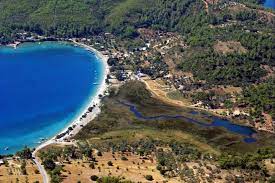Milas is the second largest district of Muğla province in the southwest of Anatolia. It is between 27 degrees 30 minutes – 28 degrees 30 minutes east longitude and 37 degrees – 37 degrees 30 minutes north latitude. Its area is 235,224 hectares.
North; Lake Bafa and the Beşparmak Mountains and the Western Menteşe Mountains, including Çomakdağı, are located. East of; Kurukümes Mountain, Akdağ and Marçalı Mountains rise. South of; Gokova (Kerme) Gulf and Datça (Reşadiye) Peninsula are on the opposite shore of the gulf. To the west, there is the Gulf of Güllük (Mandalya) and the Bodrum Peninsula.
Neighbors of Milas; Söke, Koçarlı and Çine districts of Aydın in the north, Yatağan and Muğla central districts of Muğla in the east and Bodrum district in the west.
Climate
Milas is in the Mediterranean climate zone. Summers are hot and dry, winters are mild and rainy. In winter, it rarely snows on the peaks of a few high mountains. The average temperature in the summer months is between 32 and 34 degrees, and sometimes even exceeding 40 degrees, the heat is oppressive. In winter, the average temperature is 12-14 degrees, although it is rarely seen below 0 degrees. Precipitation intensifies during the winter months. Sometimes in May and June, the rains of Kirkikindi are seen.
More northerly and southerly winds are seen in Milas. In summer, the north winds and winds cause the air to feel extremely hot, and in winter, it makes it freezing frosty. The breeze from the southerly winds cools in the summer and warms the air in the winter; In southwestern Turkey, it warms the air in winter and brings rain.
Transportation
to Milas; Transportation is provided by Bodrum-Milas-Söke-İzmir or Bodrum-Milas-Yatağan-Çine-Aydin-Denizli or Milas-Yatağan-Muğla-Fethiye-Antalya highway. There is also a widespread transportation network among 114 neighborhoods located outside the center of Milas.
The International Milas – Bodrum Airport within the boundaries of the district connects Milas to domestic and foreign centers by air. This airport is 10 km from Milas. away.
Milas has a total length of 197.4 km in the Gulf of Güllük and Gökova. Güllük Pier is an important import and export pier, as it is the gateway of Milas and Southwest Anatolia to the sea. The Ören Pier in the south, which was used in the export of emery stone and lignite coal in the late 19th and early 20th centuries, has now become a frequent destination for yachts on their way back from Bodrum to Gökova along with Çökertme Bay.
History
Milas is a city of history and culture with at least 5 thousand years of history. It was the most important city of the Carian Civilization, which ruled in the southwest of Anatolia in ancient times. Mylasa, as it was called in Antiquity, was established in the west of this mountainous country, at the foot of Sodra Mountain. It was the capital city twice in history, during the Karia and Menteşe Principalities. Carian, Roman, Byzantine, Seljuk, Menteşe and Ottoman civilizations ruled in Milas. Today, there are many historical artifacts from these civilizations in and around Milas.
Mylasa, which takes its name from Mylasos, a descendant of the god of winds, Ailos, dates back to 1,000 BC, according to archaeological research. According to the famous geographer Strabo, who lived in the 1st century BC, the origin of the word Karia comes from the “tortured tolga”. The city became an important city and satrapy center during the Carian Period. After 280 BC, the Kingdom of Pergamon dominated Caria.
In the history of Milas, 27 ancient cities were established and from these cities, the ancient cities of Iasos, Labranda, Euromos and Herakleia have come to the present day. In addition, Gümüşkesen Grave Monument, which is the only tomb monument that has survived with all its elements, was inspired by the Moseleum in Bodrum, which is considered one of the seven wonders of the world, and is a miniature of it. Aqueducts from the Roman Period and Beçin, the city of Menteşe Principality, are still standing with their works from that period.
In ancient times, Milas was a city famous for its marbles. The presence of marble quarries in Sodra, which is close to the city, and the easy obtaining of the materials required for construction enabled Mylasa to be equipped with many temples. Later, Mylasa came under Roman rule and the borders of Milas became the widest during the Byzantine Period. From the second half of the 13th century, it came under the rule of the Turks. With the proclamation of the Republic in 1923, it became a district of Muğla province.
PLACES TO VISIT
• Historical Environment
• Natural beauties
• Cultural Environment




